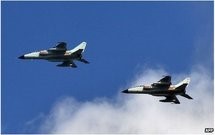 In recent years, Asia-Pacific region has caught global attention more for periodic political upheavals than for its economic dynamism. Most of the political turmoil, significantly, has been caused by the fastest growing economy—the people’s Republic of China.
In recent years, Asia-Pacific region has caught global attention more for periodic political upheavals than for its economic dynamism. Most of the political turmoil, significantly, has been caused by the fastest growing economy—the people’s Republic of China.
The apprehension that economically sound China will generate political heat and will lead to muscular assertion of Chinese influence seems to be coming true. The latest in the series of regional political turbulences has been sparked once again by China when the Xi Jinping government made a unilateral decision to establish an Air Defence Identification Zone and asked other countries to inform the Chinese authorities in advance any of their aircraft entering the zone or else face “emergency defence measures”.
This sudden declaration on 23 November last surprised many countries and forced some to react strongly. While Japan asked its civil airlines to reject Chinese authority, the United States responded after two days by flying one of its nuclear capable B 52 bombers over the zone without informing the Chinese. While the Obama Administration stated that the aircraft was unarmed, who had the ability to verify?
Obviously, the United States did not desire to take a step that would unnecessary spark military confrontation, but its quick response aimed at sending a strong signal that the Pentagon would not tolerate imposition of any restrictions on the open skies by the Chinese. Subsequently Japan and South Korea, two American allies housing US military bases and thousands of US troops, followed the US example and sent their own aircraft to fly through the zone without informing China. South Korea went a step ahead and declared its own ADIZ that overlapped the Chinese ADIZ, significantly over a disputed islet, called Leodo. The Lower House of the Japanese Diet passed a resolution against China’s behaviour in East China Sea.
It is inconceivable that Japan and South Korea would have responded so strongly without Washington winking at those moves. The smart move by the US, after the voyage of B 52 bombers, was reflected in the advisory the Obama administration issued to US airlines to respect the Chinese ADIZ and inform the Chinese authorities, while entering the zone.
What explains the US behaviour and ambiguous measures? US Secretary of State John Kerry goes to Tokyo and Seoul and reiterates US commitments to the respective alliances close on the heels of the Chinese declaration of the ADIZ. Then he goes to Beijing and says little during his interactions with the media after five hours of discussion with President Xi Jinping.
There was, of course, a precedent to such US diplomatic ambiguities. Last year, Sino-Japanese tension over the sovereignty claims on Shenkaku/Diaoyu islands in the East China Sea flared up soon after the Japanese government bought those islands from Japanese owners. The United States at once reiterated its commitment to US-Japan Treaty of Alliance and simultaneously assuaged Beijing that Washington would not take a position on the sovereignty issue.
The Chinese assertiveness and the American responses speak volumes of slow but steady emergence of a new kind of relationship between the existing superpower and the emerging superpower. This is not a new kind of major power relationship that President Xi Jinping proposed during his summit with President Barak Obama in June last year. This is also not the kind of a G-2 relationship that the Obama Administration envisioned during the early years of his first term.
The emerging pattern of Sino-US interactions symbolizes “cold confrontation” between a hegemon that appears to be experiencing relative decline of its influence in world affairs and a rising power that has begun to assert its position in the world after its miraculous economic achievements.
The US strategic planners have long been carefully monitoring China’s military modernization, particularly capacity building of its Air Force and the Navy. The US suspects that the PLA has been striving hard to acquire sea-denial and anti-access capabilities that would compromise the so-far-unrestricted mobility of the US navy and air force in the Asia Pacific region. In fact, the Pentagon has already made investment, despite the defence budget cut, to develop a new concept of Air-Sea Battle that would render Chinese anti-access/sea-denial strength vulnerable.
Courtesy : Institute of Peace and Conflict Studies (http://www.ipcs.org)